|
Getting your Trinity Audio player ready…
|
The Livestock Growth Plan seeks to address a number of challenges that are constraining livestock production, productivity, and profitability, a government official has said.

Dr. Josphat Nyika, the Chief Director of the Department of Veterinary Services revealed this at a discussion by the Livestock Business Forum that focused on the many issues affecting the livestock sector that was held today at the Meikles Hotel in Harare.
“Our aim is to make sure the livestock sector plays its role among other key sectors in the country. To achieve the stated vision, the Country has come up with a number of blueprints to guide the processes. Currently, the country is implementing National Development Strategy 1 2021 -2025 (NDS 1), which was preceded by the transitional Stabilization Program 2018 -2020 and will be succeeded by National Development Strategy 2 2026 -2030 (NDS 2). NDS 1 is anchored by a number of sub-strategies among which is the Agriculture and Food Systems Transformation Strategy 2021 -2025, which in turn is underpinned by a number of implementation plans one of which is the Livestock Growth Plan 2021 – 2025.
“The Livestock Growth Plan seeks to address a number of challenges that are constraining livestock production, productivity, and profitability. The plan targets to ameliorate challenges in the key areas of animal health, animal genetics, animal nutrition, and other related parameters. Challenges facing the livestock sector emanate from a variety of sources, which are best articulated by those directly involved at the various node of the value chain from production to marketing,” Dr. Nyika said.
Dr. Jairos Machakwa, the Director of Veterinary Field Services in an overview of the animal disease situation in the 2021/2022 period, said animal health is one of the major challenges faced by livestock farmers across their spectrum of experience and sector.
“Major diseases are affecting the livestock industry. These include the Foot and Mouth Disease, tick-borne diseases (Theileriosis), Newcastle, Lumpy skin disease, Blackleg, and Anthrax. Other diseases that are affecting production and threatening food security include fowl pox, infectious bursal disease, orf, pulp kidney, brucellosis, and mastitis. The Department of Veterinary Services has in place government-funded disease prevention and control programs for some of the above diseases and pests,” Dr. Machakwa said.
He cited inadequacy of vaccines, dip chemicals, sampling equipment, laboratory reagents; fake vaccines, dip chemicals, sampling equipment, laboratory reagents; and the lack of industry support to establish a business in the communities comprising abattoirs, drug shops, research and, incubation hubs, as well as extension services as some of the challenges dogging the livestock sector.
Nyasha Taderera, an Economist with the Zimbabwe Farmers’ Union highlighted current policy constraints on the livestock sector.
She said the primary production of livestock is estimated to contribute 22% of the agricultural GDP thus a major contributor to the attainment of the National Food and Nutrition Security Policy
However, she said a significant number of existing regulations militate against the attainment of goals in the draft livestock policy across all the livestock value chains from input acquisition, production, and marketing to the processing of livestock products.
Therefore, there is a need to ensure the policy environment is conducive to growth.
“The current policy of the Grain Marketing Board (GMB) of buying maize at prices that exceed import parity has led to side-marketing by contracted maize farmers to the GMB and thereby discouraging contract farming relationships by Animal feed manufacturers. The high prices of maize also have a negative effect on the high cost of animal feeds. However, the price floor price set for the current marketing season is based on the landed price of Zambian maize,” Taderera said.
On the other hand, the current government policy allows flour imports, with the rest of the annual requirements being made up of wheat grain that is milled locally. This reduces the opportunity by millers to value add imported wheat grain. This creates decreased availability of wheat bran, a key raw material for stockfeed production.
Taderera recommended that the government put in place a policy that encourages the importation of wheat grain rather than processed flour imports
She alluded to the high cost of compliance, particularly rural district council levies, movement permits for farmers, and the high cost of compliance for stock feed producers, and called on the issuance of import permits to be done under one roof.
The other challenge is that livestock extension services are limited and extension services are more biased toward crops. The current budget allocation towards extension 2-3% of the allocation given to agriculture is also inadequate.
Agriculture is an important sector in Zimbabwe’s economy accounting for 11% of the Gross Domestic Product (GDP). It provides economic livelihoods to 66% of the national population living in rural areas. Almost all of the 2.1million agricultural families are engaged in one or more livestock production enterprises.
The major livestock production enterprises – beef cattle, dairy cattle, goat and sheep, pigs, rabbits, poultry, and fish farming generate an estimated 19.1% of the agricultural net output every year. The livestock sector is an important source of nutritious food to the Zimbabwean population, critical inputs for crop production, raw materials for the agro-processing industry, income, and capital wealth creation for the farmers and investment community.
Zimbabwe has experienced a transition phase in terms of livestock ownership, with smallholder farmers owning more than 90% of the total livestock. Despite this, unlocking the value of livestock is the major bottleneck facing these farmers in realizing full benefits from various livestock enterprises.
The livestock sector produces animal protein consumer products – red meat, poultry meat, fish and rabbit meat, table eggs, and milk essential for national food security and nutrition. The demand for livestock consumer products is predictably expected to rise dramatically with domestic population growth and urbanization and income growth as Zimbabwe transitions from Lower- Middle Income Country to Upper-Middle Income Country over the next 10 to 15 years. The demand for all livestock products is set to increase, yet average productivity is falling among the majority of livestock farmers. Retaining current levels of national self-sufficiency in domestic production of livestock proteins will require significant and sustained improvement in domestic livestock production and marketing efficiencies in both the smallholder livestock sector and larger-scale livestock production sectors over the next ten years.
As a signatory to the Africa Continental Free Trade Agreement (AfCFA), Zimbabwe’s livestock production and marketing system have a limited window of time ( 10 to 15 years) to catch up with advanced African economies on agriculture and livestock productivity and price competitiveness against the potential imports of livestock products from leading African producers of internationally traded livestock consumer food products like milk and dairy products, beef, goat meat, pork, broiler chicken cuts, rabbit meat, livestock offal, table eggs, and fish.
The Ministry of Agriculture under its partnership with the Food and Agriculture Organization of the United Nations (FAO), the EU-funded Zimbabwe Agricultural Growth Programme (ZAGP) is working with SAFE and other ZAGP projects (BEST, IPVC, VALUE, ZAKIS) in the livestock sector to revive and strengthen the inclusive coordination of the livestock production sector through organizational development of livestock production committees and associations for effective engagement with other relatively more organized livestock value chain actors through organizing regular livestock business meetings and networking events at district, provincial and national levels.
